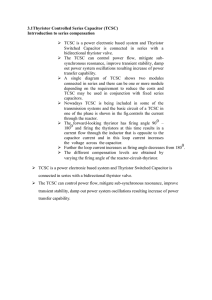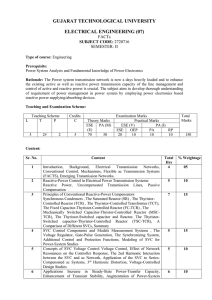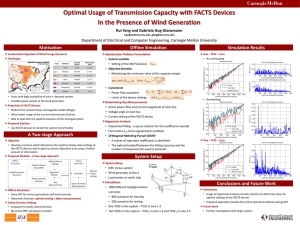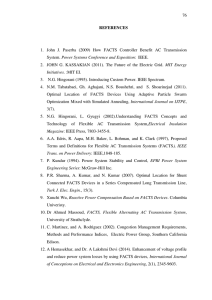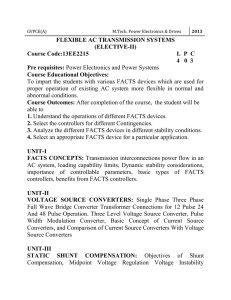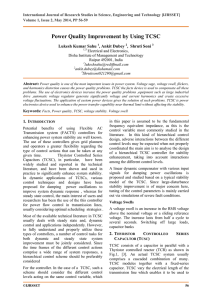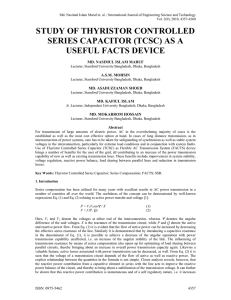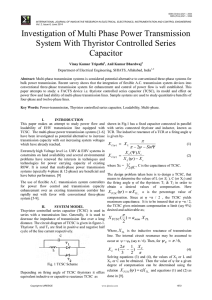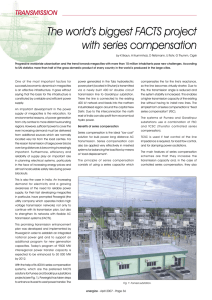TCSC: Thyristor Controlled Series Capacitor Overview
advertisement
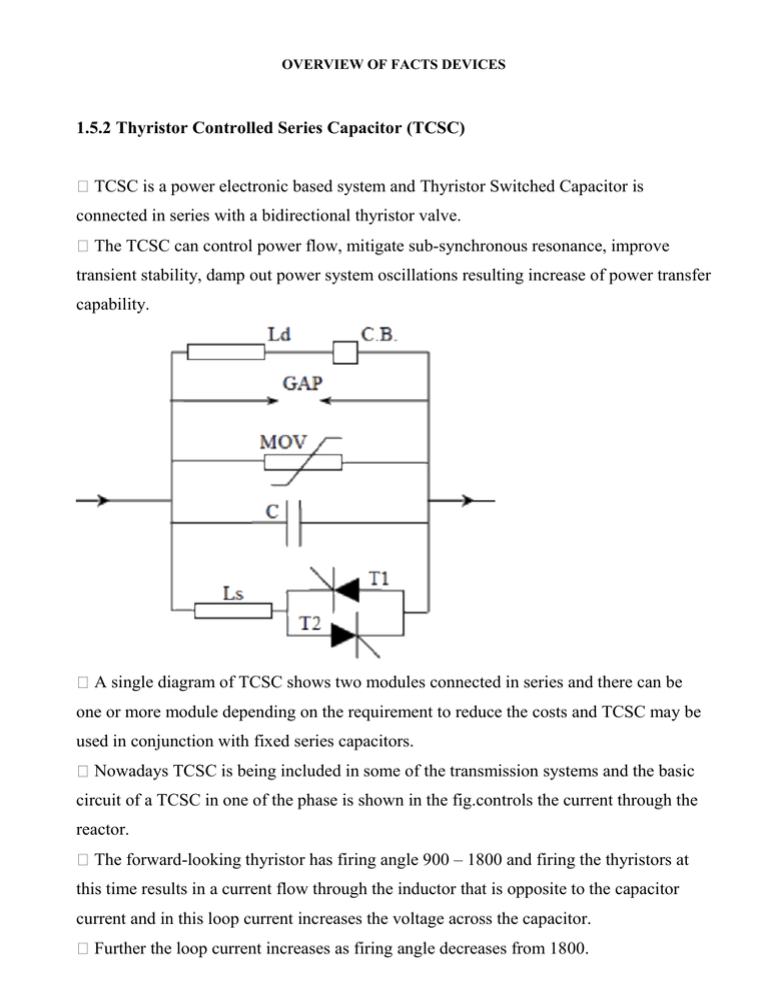
OVERVIEW OF FACTS DEVICES 1.5.2 Thyristor Controlled Series Capacitor (TCSC) TCSC is a power electronic based system and Thyristor Switched Capacitor is connected in series with a bidirectional thyristor valve. The TCSC can control power flow, mitigate sub-synchronous resonance, improve transient stability, damp out power system oscillations resulting increase of power transfer capability. A single diagram of TCSC shows two modules connected in series and there can be one or more module depending on the requirement to reduce the costs and TCSC may be used in conjunction with fixed series capacitors. Nowadays TCSC is being included in some of the transmission systems and the basic circuit of a TCSC in one of the phase is shown in the fig.controls the current through the reactor. The forward-looking thyristor has firing angle 900 – 1800 and firing the thyristors at this time results in a current flow through the inductor that is opposite to the capacitor current and in this loop current increases the voltage across the capacitor. Further the loop current increases as firing angle decreases from 1800. The different compensation levels are obtained by varying the firing angle of the reactor-circuit-thyristor. Basic Principle A TCSC is a series-controlled capacitive reactance that can provide continuous control of power on the ac line over a wide range. The principle of variable-series compensation is simply to increase the fundamental-frequency voltage across an fixed capacitor (FC) in a series compensated line through appropriate variation of the firing angle. This enhanced voltage changes the effective value of the series-capacitive reactance. A simple understanding of TCSC functioning can be obtained by analyzing the behavior of a variable inductor connected in parallel with an FC, as shown in Fig. The equivalent impedance, Zeq, of this LC combination is expressed as The impedance of the FC alone, however, is given by −j(1/ ωC). If ωC−(1/ ωL) > 0 or, in other words, ωL > (1/ ωC), the reactance of the FC is less than that of the parallel-connected variable reactor and that this combination provides a variable-capacitive reactance are both implied. Moreover, this inductor increases the equivalent-capacitive reactance of the LC combination above that of the FC. If ωC − (1/ ωL) c 0, a resonance develops that results in an infinite-capacitive impedance is obviously unacceptable condition. If, however, ωC − (1/ ωL) < 0, the LC combination provides inductance above the value of the fixed inductor. This situation corresponds to the inductive-vernier mode of the TCSC operation. In the variable-capacitance mode of the TCSC, as the inductive reactance of the variable inductor is increased, the equivalent-capacitive eactance is gradually decreased. The minimum equivalent-capacitive reactance is obtained for extremely large inductive reactance or when the variable inductor is open-circuited, in which the value is equal to the reactance of the FC itself. The behavior of the TCSC is similar to that of the parallel LC combination. The difference is that the LC-combination analysis is based on the presence of pure sinusoidal voltage and current in the circuit, whereas in the TCSC, because of the voltage and current in the FC and thyristor-controlled reactor (TCR) are not sinusoidal because of thyristor switchings. A Variable inductor connected in shunt with an FC APPLICATIONS 3.3.1 Introduction Thyristor-controlled series capacitors (TCSCs) can be used for several power system performance enhancements, namely, the improvement in system stability, the damping of power oscillations, the alleviation of sub synchronous resonance (SSR), and the prevention of voltage collapse. The effectiveness of TCSC controllers is dependent largely on their proper placement within the carefully selected control signals for achieving different functions. Although TCSCs operate in highly nonlinear power-system environments, linearcontrol techniques are used extensively for the design of TCSC controllers. 3.3.2 Improvement of the System – Stability Limit During the outage of a critical line in a meshed system, a large volume of power tends to flow in parallel transmission paths, which may become severely overloaded. Providing fixed-series compensation on the parallel path to augment the powertransfer capability appears to be a feasible solution, but it may increase the total system losses. Therefore, it is advantageous to install a TCSC in key transmission paths, which can adapt its series-compensation level to the instantaneous system requirements and provide a lower loss alternative to fixed-series compensation. The series compensation provided by the TCSC can be adjusted rapidly to ensure specified magnitudes of power flow along designated transmission lines. This condition is evident from the TCSC’s efficiency, that is, ability to change its power flow as a function of its capacitive-reactance setting: This change in transmitted power is further accomplished with minimal influence on the voltage of interconnecting buses, as it introduces voltage in quadrature. In contrast, the SVC improves power transfer by substantially modifying the interconnecting bus voltage, which may change the power into any connected passive loads. The freedom to locate a TCSC almost anywhere in a line is a significant advantage. Power-flow control does not necessitate the high-speed operation of power flow control devices and hence discrete control through a TSSC may also be adequate in certain situations. However, the TCSC cannot reverse the power flow in a line, unlike HVDC controllers and phase shifters.
